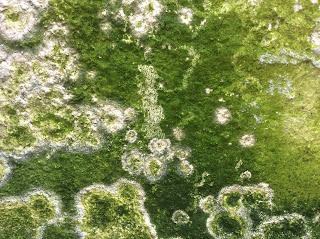Once the eye has focused discovery becomes an a focal point and natures textures and patterns became obvious and unveiled attracting my attention.
Rusty grate covers in the college car park held fascination with their man made markings high lighted by the varying rust coloured layers as did the lichens and natural textures on young trees lining the pathway. My subject matter was complete. Wear, tear and New growth of winter's tale. I felt that I had an exciting haul of information to create textile art pieces quite different to anything else I had done.
Early art work to convey my discoveries were produced by painting screens with Procion dyes to create the essence of my subject . By using this format I was less in control of the outcome which could open up other interesting developments. So I worked with watercolour paper using a thick heavy weight rag type which could hold the dye without the liquid content causing the paper to buckle as it dried. This was of course experimental and could go horribly wrong and become a gloopy mess.
 |
| Print of a mossy wall |
 |
| Reverse side print, wear and tear from mill dye room wall |










